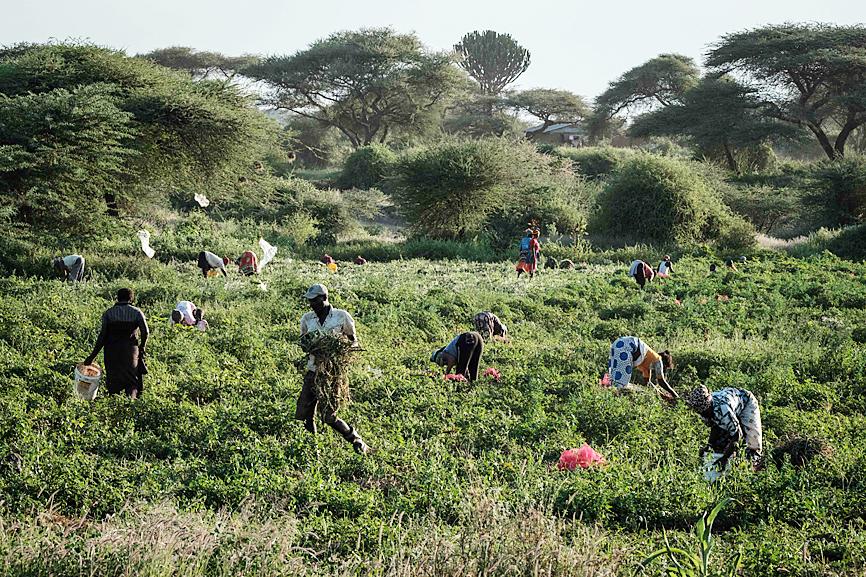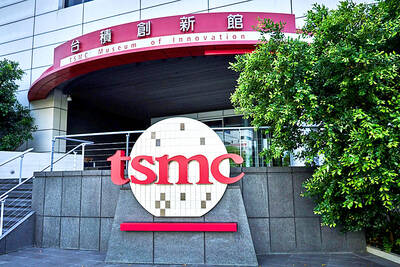Wilson Lang’at has over the past year made a steady profit from his farm in Koiyet village, managing to obtain the seeds and fertilizer he needs, planning ahead for droughts and floods, and borrowing money to diversify his crops — all through his phone.
His experience is not the norm, as most farmers across Kenya have struggled with the double hit of extreme weather shrinking their yields and COVID-19 lockdowns and curfews choking off access to supplies and demand for their produce.
Until two years ago, the 46-year-old father of six traded cows while growing corn on the side at his 2.5 hectare farm in Kenya’s Rift Valley. Then he started using the DigiFarm app to access farming inputs, weather reports and financing.

Photo: AFP
Lang’at said he went from producing 219kg of corn per hectare to about 728kg per hectare, as well as beans, potatoes and tomatoes — and quickly earned enough that he could drop the bovine arm of his business.
“Since the start of the COVID-19 pandemic, I have never stopped farming. Farming has become more profitable [than cows], and now it’s my full-time job,” he said.
In Africa, experts say agricultural technology, or agri-tech, such as DigiFarm is increasingly playing a crucial role in cushioning small-scale farmers against the crop-damaging effects of climate change and the economic pain of the pandemic.
There are about 4.5 million small-scale farmers in Kenya and their collective output accounts for more than 60 percent of the country’s food, government figures showed.
DigiFarm, a free service from telecoms giant Safaricom, was launched in 2017 — but the bulk of its 1.4 million users signed up after the pandemic hit, DigiFarm customer experience lead Elizabeth Mudogo said.
Daniel Langat, a DigiFarm village adviser in Bomet County, where Koiyet is located, said the app saves farmers time and money.
After ordering through the app, farmers receive short message service notifications when their goods are ready for collection at a local depot — the company has nearly 30 in Bomet alone — and they can get store credit and discounts, Langat said.
DigiFarm also helps farmers prepare for more erratic weather patterns by sending them information on best practices and tips to reduce crop loss, along with historical weather reports and forecasts.
“This app has brought farmers together in our area,” Langat said. “As all the farmers plant at the same time since they get weather updates at the same time, this helps in disease control and decisionmaking.”
In case farmers do still suffer unexpected crop losses, DigiFarm offers insurance and loans through popular mobile money platform M-Pesa.
During the pandemic, Lang’at borrowed 1,300 Kenyan shillings (US$12) through the app to buy tomato seeds. He earned more than 50 times that selling the produce, which enabled him to pay one of his children’s college fees.
“Planning is easier. [For example] when I receive updates of low rainfall, I plant beans, which do well with shorter rains,” he said.
TURNING TO TECH
An April report from the Netherlands-based Technical Centre for Agricultural and Rural Cooperation said that Africa’s digital agricultural services sector has grown nearly 45 percent annually in terms of farmers reached over the past three years.
Since the start of the pandemic, Kenyan company Twiga Foods Ltd has seen a jump in the number of farmers using its digital platform Soko Yetu (Our Market) to reach customers without going through expensive brokers, Twiga chief technology officer Caine Wanjau said.
Twiga, which launched in 2014, harvests and buys produce from its member farms, then takes the goods to collection centers for processing and packaging, he said.
When vendors order something through the app, the company delivers it to their stores.
Originally operating only in Nairobi, the platform expanded to five other major towns in Kenya during the pandemic and recently announced a new expansion into Uganda, Wanjau said.
The app now covers more than 17,000 farmers and 35,000 vendors, he added.
Ann Waithera signed up to Twiga a year ago to help her keep running her general store on the outskirts of Nairobi.
Instead of going to markets to buy goods, she places her order from home and it is delivered the following morning.
“Nowadays, the market is on my phone. I save over 500 shillings [every day], which would have been used for transport, and I no longer wake up at 4am to go to the market in Nairobi, so now I can be with my kids,” she said.
LOW-INCOME FARMERS
A January report by consultancy McKinsey & Co said that farmers across sub-Saharan Africa are using more than 400 apps and digital platforms for everything from accessing financial services and planting advice to supply chain management.
However, uptake of these apps is limited by tech challenges such as lack of Internet access for farmers, with 3G networks covering only about 40 percent of sub-Saharan Africa’s rural areas, while half of the region has no grid electricity, it said.
Still, David J. Spielman, a senior researcher at the Washington-based International Food Policy Research Institute, said agri-tech apps are already helping build the climate resilience of small-scale farmers.
“Crop and livestock yields and production are edging upwards in Africa — the larger issue is that this rate of growth has to increase,” he wrote in an e-mail.
To do that, he urged developers to focus more on tools for poorer and other marginalized communities, so that platforms can address their specific needs.
For example, some technologies provide weather information when the real constraint facing farmers in a particular area might be access to credit and finance.
“There is significant potential growth of digital innovation across the region if developers and providers can figure out how to genuinely target and benefit people in low-income groups,” Spielman said.

SEEKING CLARITY: Washington should not adopt measures that create uncertainties for ‘existing semiconductor investments,’ TSMC said referring to its US$165 billion in the US Taiwan Semiconductor Manufacturing Co (TSMC, 台積電) told the US that any future tariffs on Taiwanese semiconductors could reduce demand for chips and derail its pledge to increase its investment in Arizona. “New import restrictions could jeopardize current US leadership in the competitive technology industry and create uncertainties for many committed semiconductor capital projects in the US, including TSMC Arizona’s significant investment plan in Phoenix,” the chipmaker wrote in a letter to the US Department of Commerce. TSMC issued the warning in response to a solicitation for comments by the department on a possible tariff on semiconductor imports by US President Donald Trump’s

‘FAILED EXPORT CONTROLS’: Jensen Huang said that Washington should maximize the speed of AI diffusion, because not doing so would give competitors an advantage Nvidia Corp cofounder and chief executive officer Jensen Huang (黃仁勳) yesterday criticized the US government’s restrictions on exports of artificial intelligence (AI) chips to China, saying that the policy was a failure and would only spur China to accelerate AI development. The export controls gave China the spirit, motivation and government support to accelerate AI development, Huang told reporters at the Computex trade show in Taipei. The competition in China is already intense, given its strong software capabilities, extensive technology ecosystems and work efficiency, he said. “All in all, the export controls were a failure. The facts would suggest it,” he said. “The US

The government has launched a three-pronged strategy to attract local and international talent, aiming to position Taiwan as a new global hub following Nvidia Corp’s announcement that it has chosen Taipei as the site of its Taiwan headquarters. Nvidia cofounder and CEO Jensen Huang (黃仁勳) on Monday last week announced during his keynote speech at the Computex trade show in Taipei that the Nvidia Constellation, the company’s planned Taiwan headquarters, would be located in the Beitou-Shilin Technology Park (北投士林科技園區) in Taipei. Huang’s decision to establish a base in Taiwan is “primarily due to Taiwan’s talent pool and its strength in the semiconductor

French President Emmanuel Macron has expressed gratitude to Hon Hai Precision Industry Co (鴻海精密) for its plan to invest approximately 250 million euros (US$278 million) in a joint venture in France focused on the semiconductor and space industries. On his official X account on Tuesday, Macron thanked Hon Hai, also known globally as Foxconn Technology Group (富士康科技集團), for its investment projects announced at Choose France, a flagship economic summit held on Monday to attract foreign investment. In the post, Macron included a GIF displaying the national flag of the Republic of China (Taiwan), as he did for other foreign investors, including China-based